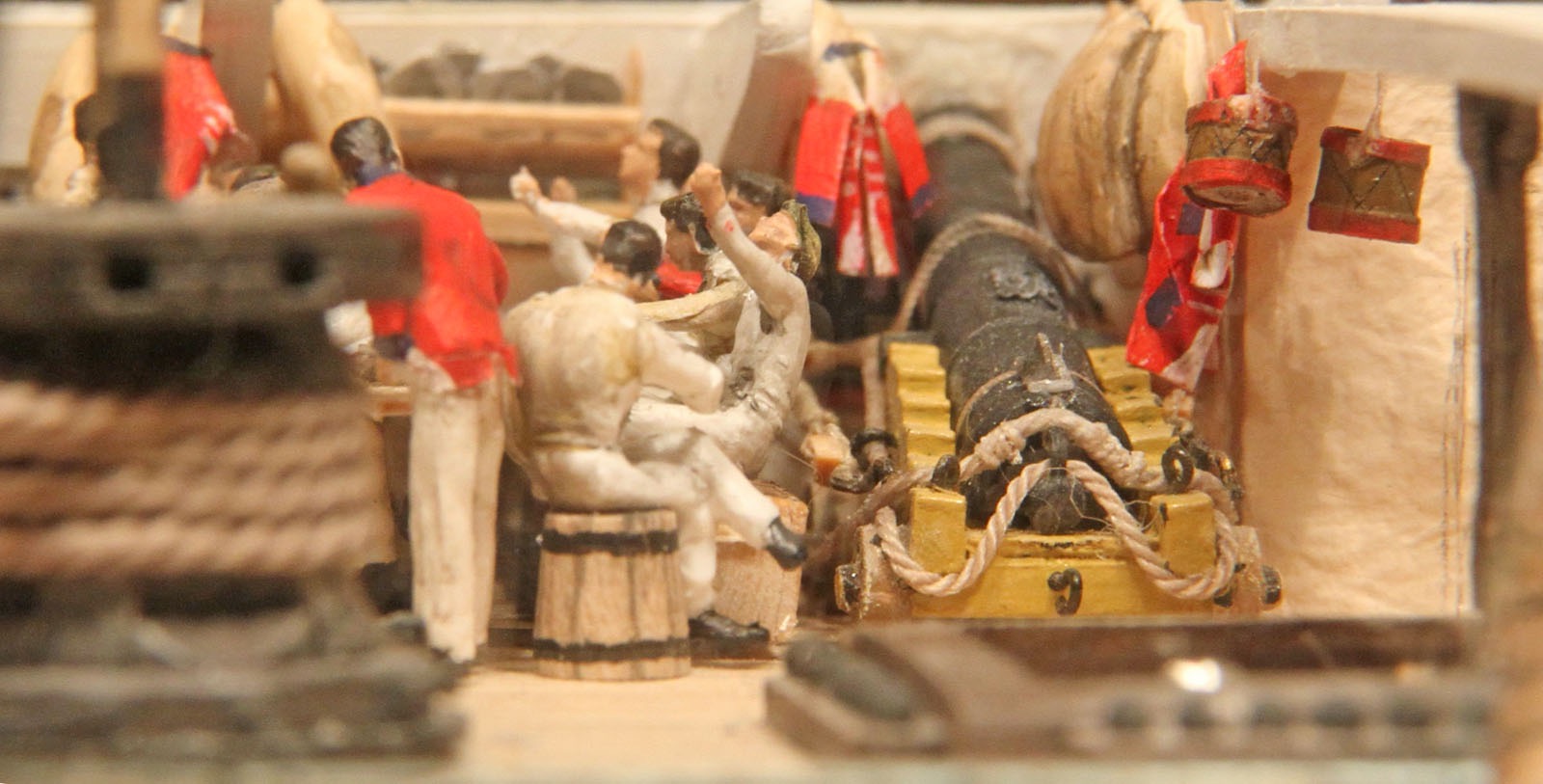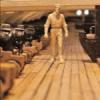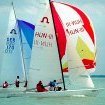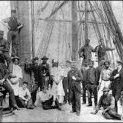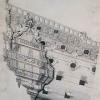-
Posts
2,387 -
Joined
-
Last visited
Reputation Activity
-
 dafi got a reaction from iMustBeCrazy in Double banked versus single banked ships' boats
dafi got a reaction from iMustBeCrazy in Double banked versus single banked ships' boats
As my quest started with the design of the oars, I was coming from the other direction, but leading my straight to the heart of this topic.
Having created oars and sweeps respecting Steel´s data, I was putting them to the test on some of my boats.
This lead first to the confimation of the knowledge, that my kit´s versions of boats are not really suitible for the job. Apart from missing all structure and details they also had the thwarts far too high. After reworking the 32 ft pinnace by using only the shell and reconstructing a more true interior it was getting nearer to the real thing.
Now I was able to put some crewmen and oars. As a good landlubber I placed immediately two of each on each thwart as suggested by the tholes.
But here began my surprise. As Steel indicated: "A leather button is nailed on the foreside, about two inches from the loom, and that edge rounded, to work easily in the rowlock: ..." This lead to the fact, that the oars were far too much in for a double banked use. Basically a crewman should be sitting on the opposite side to be able to grab the handle of his oar, thus crossing the other one.
The other fact that can be seen is that in this configuration the crewmen sit far too much on the outside of the boat, resulting in a ridiculus lever for rowing, as already mentioned by Roger in #2. So even if the leather buttom was ignored and the oar taken more out, it would have been a problematic setup.
This resulted in the only realistic setup with single banked use and everything looked much more logical.
The lengths of the oars fit, the leather button on the right place and a realistic lever for rowing.
On the other side I also tried a more broad launch.
For these Steel indicated straight sweeps without leather buttom.
[note: This is still the original kit´s version, but I think it will do the job this time.]
Here we have the space for double banked use. The sweeps do not collide in the middle and the crewmen have enough distance to the rowlock to get a workable lever. This confirmes Allans original quote of Lavery's The Arming and Fitting of English Ships of War where he writes that "in 1783 it was ordered that all launches should be equipped to row double banked."
And so I am thankful for the topic here, as it was filling the gaps of my puzzle and giving the right contemporary sources to finish it off. This means with my single banked 32ft pinnace from the first pictures I will fill every second thole, alternating on each side. Also the originally intended number supplied of oars (as for double banked and seen in the first pict) for this boat can be halved.
Another question concernes the uneven number of oars on each side, in my 32ft pinnace 4 versus 3. Was this in use as for the uneven propulsion or was the bow place then left free? On the other side in the models of RMG there are many boats with a uneven number of tholes regarding the boat´s sides.
As someone once called it "experimental archeology in miniature" 😉
I hope it supports or even confirms all the informations to be found in the previous posts.
XXXDAn
PS: Had a fast Photoshop and eliminated the supernumerary tholes.
This gives a nice detail in between single and double banked boats even in stowed position. 🙂
-
 dafi got a reaction from Fritzlindsay in Double banked versus single banked ships' boats
dafi got a reaction from Fritzlindsay in Double banked versus single banked ships' boats
Wonderful, once I saw this info I already found plenty of otherwise very true models showing this "feature" 🙂
But I would expect an even number of twarts for single banked, but there is quite often an uneven number. Does this mean the lesser side had to pull harder or was there one thole left free?
Also there seems no rule as to what side of the boat has the most foreward thole.
XXXDAn
-
 dafi reacted to iMustBeCrazy in Double banked versus single banked ships' boats
dafi reacted to iMustBeCrazy in Double banked versus single banked ships' boats
I came across this pic of Police on the Thames which opens a new can of worms:
-
 dafi got a reaction from druxey in Double banked versus single banked ships' boats
dafi got a reaction from druxey in Double banked versus single banked ships' boats
Thank you bringing up this topic again, as I am at the moment working on that.
After working on the sweeps and oars, the question was arising, as the oars prooved too long for double banked use. This thread nicely shows the solution as mostely single banked were used was for the "slimmer" boats. Nicely to be seen for my 1800 subject in the 1765 model of victory.
I have the feeling too, that for single banked use oars with a curved blade were used, while for double banked use sweeps with a straight blade were preferred. At least the choice of RMG suggests this.
Some more hints from the RMG, sorry I did loose the reference numbers on those ones.
alternating single banked with oars
double banked with sweeps:
Special both versions?
perhaps single bancked for 4 oars or alternatively 2 pairs of sculls?
-
 dafi got a reaction from iMustBeCrazy in Double banked versus single banked ships' boats
dafi got a reaction from iMustBeCrazy in Double banked versus single banked ships' boats
Thank you bringing up this topic again, as I am at the moment working on that.
After working on the sweeps and oars, the question was arising, as the oars prooved too long for double banked use. This thread nicely shows the solution as mostely single banked were used was for the "slimmer" boats. Nicely to be seen for my 1800 subject in the 1765 model of victory.
I have the feeling too, that for single banked use oars with a curved blade were used, while for double banked use sweeps with a straight blade were preferred. At least the choice of RMG suggests this.
Some more hints from the RMG, sorry I did loose the reference numbers on those ones.
alternating single banked with oars
double banked with sweeps:
Special both versions?
perhaps single bancked for 4 oars or alternatively 2 pairs of sculls?
-
 dafi got a reaction from cotrecerf in Double banked versus single banked ships' boats
dafi got a reaction from cotrecerf in Double banked versus single banked ships' boats
Thank you bringing up this topic again, as I am at the moment working on that.
After working on the sweeps and oars, the question was arising, as the oars prooved too long for double banked use. This thread nicely shows the solution as mostely single banked were used was for the "slimmer" boats. Nicely to be seen for my 1800 subject in the 1765 model of victory.
I have the feeling too, that for single banked use oars with a curved blade were used, while for double banked use sweeps with a straight blade were preferred. At least the choice of RMG suggests this.
Some more hints from the RMG, sorry I did loose the reference numbers on those ones.
alternating single banked with oars
double banked with sweeps:
Special both versions?
perhaps single bancked for 4 oars or alternatively 2 pairs of sculls?
-
 dafi reacted to iMustBeCrazy in Double banked versus single banked ships' boats
dafi reacted to iMustBeCrazy in Double banked versus single banked ships' boats
This is what I can come up with for pinnaces:
-
 dafi got a reaction from Fritzlindsay in Sweeps and Oars
dafi got a reaction from Fritzlindsay in Sweeps and Oars
Parallel to the 1803 ad 1910 Vics, I have been working on the boats. Or rather on the oars. The trigger was once again the "egytian paddles" that had found their way onto an otherwise great model.
To start with I did not yet get in contact about that topic. How long? What form? I had no idea. Hope you will be able to cofirm the ext steps.
Fortunately, I was given quite fast a reference to David Steel's "The art of Making Masts, Yards, Gaffs, Booms, Blocks, and Oars, as Practised in the Royal Navy, and According to the Most Approved Methods in the ... of an Improved Rule for Mast-makers", a volume I wasn´t aware of before. I just ordered my copy as I found no official legal online source. In there the relevant iformatios were given in 4 tables.
Oar-Making
The different parts of oars are described by the engraved figures, and their dimensions by the tables.
Ships’ sweeps and oars are made of hand-masts, or rafters, suited to the size and length, as per table. They should be chosen straight-grained, free from large knots, shakes, or rind-galls. They are first sawed, or jambed in a snatch-block, and hewed nearly to their size; then raised on horses, and completed by the drawing-knife, spoke-shave, or plane. Open handles are nailed to the sides of the loom in the direction of the flat of the blade, made of oak, about one inch and three-quarters deep, and two inches and one-quarter thick, hollowed to admit the hand easy between that and the loom: the length of the handle is one-third the length of the loom.
Barges’, lighters’ and ships’ boats’, oars are made of fir-rafters, similar to ships’, without handles to the sides of the loom.
N.B. The looms of boats’ oars are often made round.
Oars and sculls for barges, wherries, and skiffs, are made of ash (and sometimes of fir) rafters, which should be chosen tough, straight-grained, without shakes or large knots. The rough wood is taken off with an axe, and finished in a neat manner on horses by drawing-knives, spoke-shaves, and planes. A leather button is nailed on the foreside, about two inches from the loom, and that edge rounded, to work easily in the rowlock: the lower end of the blade is strapped round with tin to prevent its splitting.
Sculls for wherries, skiffs, &c. for choice and make are similar to wherries’ oars.
The sizes relevant for my Victory boats are the sweeps for the larger workboats with straight blades and the oars with curved blades for the smaller boats.
First the sweeps.
They have an interesting shape. The thin round handle, the square loom, the round to elliptical shank which then transitions back into the flat of the blade.
And here is the oar.
Here the design is even more differentiated: round handle, rectangular loom, elliptical shank and the curved flat blade. Here, contemporary models are much more relaxed in the curve, which is why I have not shaped it as extremly as seen in Steel.
Also the blades have a reinforcement against splintering on the outer end, in the contemporary models usually formed as a ring and not over the edge as with Steel.
And, as always, the fallacy: It's programmed, so it can be printed straight away 🙂
Shull bit.
It took a lot of convincing, but in the end something useful came out.
Then some more color, dark brown primer and a lighter tone as brushing.
And to top it all off, a close-up 🙂
If compared to the model oars and sweeps in RGM it seems the right direction.
Still puzzeled about the triangular piece of leather that keeps the oar in place. How did it look and how was it fixed?
All the best, DAniel
XXXDA
-
 dafi got a reaction from eatcrow2 in L'Hermione Main Deck Solid Shot Storage
dafi got a reaction from eatcrow2 in L'Hermione Main Deck Solid Shot Storage
This is how the british stored their extra shot as found in the wrecks at Thorsminde from 1811.
XXXDAn
-
 dafi got a reaction from wefalck in Sweeps and Oars
dafi got a reaction from wefalck in Sweeps and Oars
Parallel to the 1803 ad 1910 Vics, I have been working on the boats. Or rather on the oars. The trigger was once again the "egytian paddles" that had found their way onto an otherwise great model.
To start with I did not yet get in contact about that topic. How long? What form? I had no idea. Hope you will be able to cofirm the ext steps.
Fortunately, I was given quite fast a reference to David Steel's "The art of Making Masts, Yards, Gaffs, Booms, Blocks, and Oars, as Practised in the Royal Navy, and According to the Most Approved Methods in the ... of an Improved Rule for Mast-makers", a volume I wasn´t aware of before. I just ordered my copy as I found no official legal online source. In there the relevant iformatios were given in 4 tables.
Oar-Making
The different parts of oars are described by the engraved figures, and their dimensions by the tables.
Ships’ sweeps and oars are made of hand-masts, or rafters, suited to the size and length, as per table. They should be chosen straight-grained, free from large knots, shakes, or rind-galls. They are first sawed, or jambed in a snatch-block, and hewed nearly to their size; then raised on horses, and completed by the drawing-knife, spoke-shave, or plane. Open handles are nailed to the sides of the loom in the direction of the flat of the blade, made of oak, about one inch and three-quarters deep, and two inches and one-quarter thick, hollowed to admit the hand easy between that and the loom: the length of the handle is one-third the length of the loom.
Barges’, lighters’ and ships’ boats’, oars are made of fir-rafters, similar to ships’, without handles to the sides of the loom.
N.B. The looms of boats’ oars are often made round.
Oars and sculls for barges, wherries, and skiffs, are made of ash (and sometimes of fir) rafters, which should be chosen tough, straight-grained, without shakes or large knots. The rough wood is taken off with an axe, and finished in a neat manner on horses by drawing-knives, spoke-shaves, and planes. A leather button is nailed on the foreside, about two inches from the loom, and that edge rounded, to work easily in the rowlock: the lower end of the blade is strapped round with tin to prevent its splitting.
Sculls for wherries, skiffs, &c. for choice and make are similar to wherries’ oars.
The sizes relevant for my Victory boats are the sweeps for the larger workboats with straight blades and the oars with curved blades for the smaller boats.
First the sweeps.
They have an interesting shape. The thin round handle, the square loom, the round to elliptical shank which then transitions back into the flat of the blade.
And here is the oar.
Here the design is even more differentiated: round handle, rectangular loom, elliptical shank and the curved flat blade. Here, contemporary models are much more relaxed in the curve, which is why I have not shaped it as extremly as seen in Steel.
Also the blades have a reinforcement against splintering on the outer end, in the contemporary models usually formed as a ring and not over the edge as with Steel.
And, as always, the fallacy: It's programmed, so it can be printed straight away 🙂
Shull bit.
It took a lot of convincing, but in the end something useful came out.
Then some more color, dark brown primer and a lighter tone as brushing.
And to top it all off, a close-up 🙂
If compared to the model oars and sweeps in RGM it seems the right direction.
Still puzzeled about the triangular piece of leather that keeps the oar in place. How did it look and how was it fixed?
All the best, DAniel
XXXDA
-
 dafi reacted to Veszett Roka in HMS Victory by dafi - Heller - PLASTIC - To Victory and beyond ...
dafi reacted to Veszett Roka in HMS Victory by dafi - Heller - PLASTIC - To Victory and beyond ...
Yes, i already noticed that too - the cover was aligned to be below the upper battery. I was brave enough to say this misalignment because knowing your seeking for perfection. So i don't know what would be the good solution
-
 dafi got a reaction from mtaylor in HMS Victory by dafi - Heller - PLASTIC - To Victory and beyond ...
dafi got a reaction from mtaylor in HMS Victory by dafi - Heller - PLASTIC - To Victory and beyond ...
Bad luck for me, thank you eagle eye!
But there is much more that won´t fit as already the ports have another rhythm. Just see the port o the lower battery and the one on the upper battery: differently aligned ...
XXXDAn
-
 dafi reacted to Kenchington in Sweeps and Oars
dafi reacted to Kenchington in Sweeps and Oars
Fascinating! I knew of Steele's work on masting etc. but not his treatment of oars.
I wonder whether anyone actually tried moving a First Rate with 52ft sweeps -- and where they might have been stowed when not in use!
Trevor
-
 dafi got a reaction from Veszett Roka in HMS Victory by dafi - Heller - PLASTIC - To Victory and beyond ...
dafi got a reaction from Veszett Roka in HMS Victory by dafi - Heller - PLASTIC - To Victory and beyond ...
Bad luck for me, thank you eagle eye!
But there is much more that won´t fit as already the ports have another rhythm. Just see the port o the lower battery and the one on the upper battery: differently aligned ...
XXXDAn
-
 dafi reacted to Veszett Roka in HMS Victory by dafi - Heller - PLASTIC - To Victory and beyond ...
dafi reacted to Veszett Roka in HMS Victory by dafi - Heller - PLASTIC - To Victory and beyond ...
Daniel, i'm afraid the covered inlet (? i dont know what is it) is mispositioned.
-
 dafi got a reaction from mtaylor in HMS Victory by dafi - Heller - PLASTIC - To Victory and beyond ...
dafi got a reaction from mtaylor in HMS Victory by dafi - Heller - PLASTIC - To Victory and beyond ...
Thank you Druxey, but that is part of the game 🙂
Just realized that I missed one entry, here it is:
I went over the stovepipe outlet cover plate underneath the fore chains. First it was reduced in size according to the source. On closer inspection of the photograph, I noticed that the support block could also be a brick. Since the entire shipyard is made of red brick, I took the opportunity to add a bit of color.
Here is my comparison picture again. The shoe for the anchor is still far too small, but the rest is slowly coming along :-)
Even more distinct without color.
As the picture is from 1920 and the state I am showing is 10 years earlier I do not know yet how much of the rot I will show.
XXXDAn
-
 dafi got a reaction from mtaylor in HMS Victory by dafi - Heller - PLASTIC - To Victory and beyond ...
dafi got a reaction from mtaylor in HMS Victory by dafi - Heller - PLASTIC - To Victory and beyond ...
Sorry Druxey if I gave you a sleepless night 😇
When the side gallery was in place, it didn't seem gloomy enough. An anxious look, and sure enough, the white balusters that I had been looking forward to so much just weren't there. Crap. And painting over it looked like crap. I'm sorry, but it did.
Like dafi does what dafi does best: Destruction!
So I broke out the white balusters and put in new black ones. Now the eyeliner is still missing in the broad white profiles and then it could work. It's only an approximation anyway, as otherwise the side galleries would have to be completely rebuilt. At that time, the curves were less pronounced and the whole structure was more angular. But I can't reconstruct it much better with the documents I have so far. Maybe later on, new sources might turn up.
And since I was just tinkering around, I added the chutes for the signal cannons. Probably so that powder and cartridge residues don't stick to the ship's side.
XXXDAn -
 dafi got a reaction from CPDDET in Sweeps and Oars
dafi got a reaction from CPDDET in Sweeps and Oars
Parallel to the 1803 ad 1910 Vics, I have been working on the boats. Or rather on the oars. The trigger was once again the "egytian paddles" that had found their way onto an otherwise great model.
To start with I did not yet get in contact about that topic. How long? What form? I had no idea. Hope you will be able to cofirm the ext steps.
Fortunately, I was given quite fast a reference to David Steel's "The art of Making Masts, Yards, Gaffs, Booms, Blocks, and Oars, as Practised in the Royal Navy, and According to the Most Approved Methods in the ... of an Improved Rule for Mast-makers", a volume I wasn´t aware of before. I just ordered my copy as I found no official legal online source. In there the relevant iformatios were given in 4 tables.
Oar-Making
The different parts of oars are described by the engraved figures, and their dimensions by the tables.
Ships’ sweeps and oars are made of hand-masts, or rafters, suited to the size and length, as per table. They should be chosen straight-grained, free from large knots, shakes, or rind-galls. They are first sawed, or jambed in a snatch-block, and hewed nearly to their size; then raised on horses, and completed by the drawing-knife, spoke-shave, or plane. Open handles are nailed to the sides of the loom in the direction of the flat of the blade, made of oak, about one inch and three-quarters deep, and two inches and one-quarter thick, hollowed to admit the hand easy between that and the loom: the length of the handle is one-third the length of the loom.
Barges’, lighters’ and ships’ boats’, oars are made of fir-rafters, similar to ships’, without handles to the sides of the loom.
N.B. The looms of boats’ oars are often made round.
Oars and sculls for barges, wherries, and skiffs, are made of ash (and sometimes of fir) rafters, which should be chosen tough, straight-grained, without shakes or large knots. The rough wood is taken off with an axe, and finished in a neat manner on horses by drawing-knives, spoke-shaves, and planes. A leather button is nailed on the foreside, about two inches from the loom, and that edge rounded, to work easily in the rowlock: the lower end of the blade is strapped round with tin to prevent its splitting.
Sculls for wherries, skiffs, &c. for choice and make are similar to wherries’ oars.
The sizes relevant for my Victory boats are the sweeps for the larger workboats with straight blades and the oars with curved blades for the smaller boats.
First the sweeps.
They have an interesting shape. The thin round handle, the square loom, the round to elliptical shank which then transitions back into the flat of the blade.
And here is the oar.
Here the design is even more differentiated: round handle, rectangular loom, elliptical shank and the curved flat blade. Here, contemporary models are much more relaxed in the curve, which is why I have not shaped it as extremly as seen in Steel.
Also the blades have a reinforcement against splintering on the outer end, in the contemporary models usually formed as a ring and not over the edge as with Steel.
And, as always, the fallacy: It's programmed, so it can be printed straight away 🙂
Shull bit.
It took a lot of convincing, but in the end something useful came out.
Then some more color, dark brown primer and a lighter tone as brushing.
And to top it all off, a close-up 🙂
If compared to the model oars and sweeps in RGM it seems the right direction.
Still puzzeled about the triangular piece of leather that keeps the oar in place. How did it look and how was it fixed?
All the best, DAniel
XXXDA
-
 dafi got a reaction from Ian_Grant in HMS Victory by dafi - Heller - PLASTIC - To Victory and beyond ...
dafi got a reaction from Ian_Grant in HMS Victory by dafi - Heller - PLASTIC - To Victory and beyond ...
Sorry Druxey if I gave you a sleepless night 😇
When the side gallery was in place, it didn't seem gloomy enough. An anxious look, and sure enough, the white balusters that I had been looking forward to so much just weren't there. Crap. And painting over it looked like crap. I'm sorry, but it did.
Like dafi does what dafi does best: Destruction!
So I broke out the white balusters and put in new black ones. Now the eyeliner is still missing in the broad white profiles and then it could work. It's only an approximation anyway, as otherwise the side galleries would have to be completely rebuilt. At that time, the curves were less pronounced and the whole structure was more angular. But I can't reconstruct it much better with the documents I have so far. Maybe later on, new sources might turn up.
And since I was just tinkering around, I added the chutes for the signal cannons. Probably so that powder and cartridge residues don't stick to the ship's side.
XXXDAn -
 dafi got a reaction from Hubac's Historian in HMS Victory by dafi - Heller - PLASTIC - To Victory and beyond ...
dafi got a reaction from Hubac's Historian in HMS Victory by dafi - Heller - PLASTIC - To Victory and beyond ...
Sorry Druxey if I gave you a sleepless night 😇
When the side gallery was in place, it didn't seem gloomy enough. An anxious look, and sure enough, the white balusters that I had been looking forward to so much just weren't there. Crap. And painting over it looked like crap. I'm sorry, but it did.
Like dafi does what dafi does best: Destruction!
So I broke out the white balusters and put in new black ones. Now the eyeliner is still missing in the broad white profiles and then it could work. It's only an approximation anyway, as otherwise the side galleries would have to be completely rebuilt. At that time, the curves were less pronounced and the whole structure was more angular. But I can't reconstruct it much better with the documents I have so far. Maybe later on, new sources might turn up.
And since I was just tinkering around, I added the chutes for the signal cannons. Probably so that powder and cartridge residues don't stick to the ship's side.
XXXDAn -
 dafi got a reaction from Mexspur in HMS Victory by dafi - Heller - PLASTIC - To Victory and beyond ...
dafi got a reaction from Mexspur in HMS Victory by dafi - Heller - PLASTIC - To Victory and beyond ...
Sorry Druxey if I gave you a sleepless night 😇
When the side gallery was in place, it didn't seem gloomy enough. An anxious look, and sure enough, the white balusters that I had been looking forward to so much just weren't there. Crap. And painting over it looked like crap. I'm sorry, but it did.
Like dafi does what dafi does best: Destruction!
So I broke out the white balusters and put in new black ones. Now the eyeliner is still missing in the broad white profiles and then it could work. It's only an approximation anyway, as otherwise the side galleries would have to be completely rebuilt. At that time, the curves were less pronounced and the whole structure was more angular. But I can't reconstruct it much better with the documents I have so far. Maybe later on, new sources might turn up.
And since I was just tinkering around, I added the chutes for the signal cannons. Probably so that powder and cartridge residues don't stick to the ship's side.
XXXDAn -
 dafi got a reaction from Thukydides in HMS Victory by dafi - Heller - PLASTIC - To Victory and beyond ...
dafi got a reaction from Thukydides in HMS Victory by dafi - Heller - PLASTIC - To Victory and beyond ...
Sorry Druxey if I gave you a sleepless night 😇
When the side gallery was in place, it didn't seem gloomy enough. An anxious look, and sure enough, the white balusters that I had been looking forward to so much just weren't there. Crap. And painting over it looked like crap. I'm sorry, but it did.
Like dafi does what dafi does best: Destruction!
So I broke out the white balusters and put in new black ones. Now the eyeliner is still missing in the broad white profiles and then it could work. It's only an approximation anyway, as otherwise the side galleries would have to be completely rebuilt. At that time, the curves were less pronounced and the whole structure was more angular. But I can't reconstruct it much better with the documents I have so far. Maybe later on, new sources might turn up.
And since I was just tinkering around, I added the chutes for the signal cannons. Probably so that powder and cartridge residues don't stick to the ship's side.
XXXDAn -
 dafi got a reaction from druxey in HMS Victory by dafi - Heller - PLASTIC - To Victory and beyond ...
dafi got a reaction from druxey in HMS Victory by dafi - Heller - PLASTIC - To Victory and beyond ...
Sorry Druxey if I gave you a sleepless night 😇
When the side gallery was in place, it didn't seem gloomy enough. An anxious look, and sure enough, the white balusters that I had been looking forward to so much just weren't there. Crap. And painting over it looked like crap. I'm sorry, but it did.
Like dafi does what dafi does best: Destruction!
So I broke out the white balusters and put in new black ones. Now the eyeliner is still missing in the broad white profiles and then it could work. It's only an approximation anyway, as otherwise the side galleries would have to be completely rebuilt. At that time, the curves were less pronounced and the whole structure was more angular. But I can't reconstruct it much better with the documents I have so far. Maybe later on, new sources might turn up.
And since I was just tinkering around, I added the chutes for the signal cannons. Probably so that powder and cartridge residues don't stick to the ship's side.
XXXDAn -
 dafi got a reaction from rybakov in HMS Victory by dafi - Heller - PLASTIC - To Victory and beyond ...
dafi got a reaction from rybakov in HMS Victory by dafi - Heller - PLASTIC - To Victory and beyond ...
Sorry Druxey if I gave you a sleepless night 😇
When the side gallery was in place, it didn't seem gloomy enough. An anxious look, and sure enough, the white balusters that I had been looking forward to so much just weren't there. Crap. And painting over it looked like crap. I'm sorry, but it did.
Like dafi does what dafi does best: Destruction!
So I broke out the white balusters and put in new black ones. Now the eyeliner is still missing in the broad white profiles and then it could work. It's only an approximation anyway, as otherwise the side galleries would have to be completely rebuilt. At that time, the curves were less pronounced and the whole structure was more angular. But I can't reconstruct it much better with the documents I have so far. Maybe later on, new sources might turn up.
And since I was just tinkering around, I added the chutes for the signal cannons. Probably so that powder and cartridge residues don't stick to the ship's side.
XXXDAn -
 dafi reacted to druxey in HMS Victory by dafi - Heller - PLASTIC - To Victory and beyond ...
dafi reacted to druxey in HMS Victory by dafi - Heller - PLASTIC - To Victory and beyond ...
Horror? Don't keep us in suspense!

